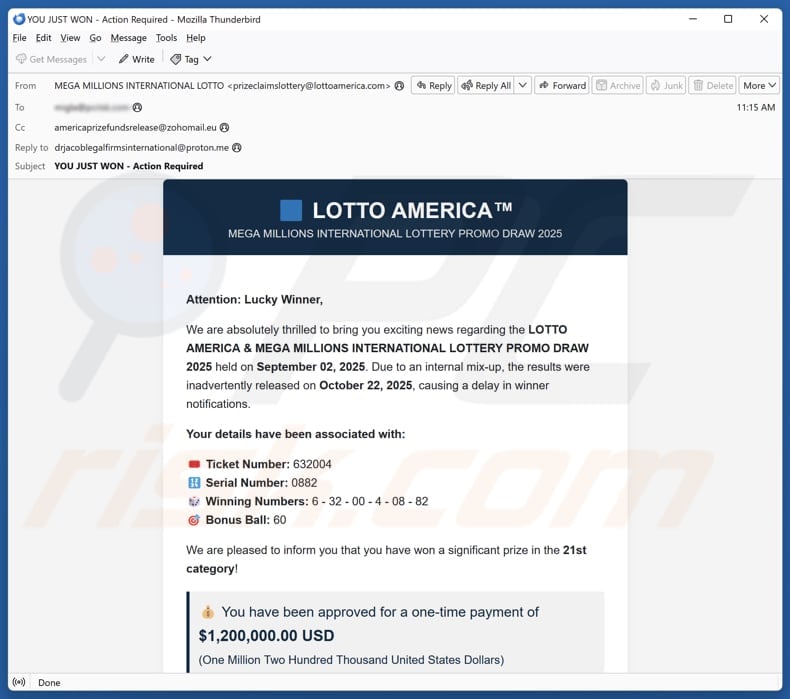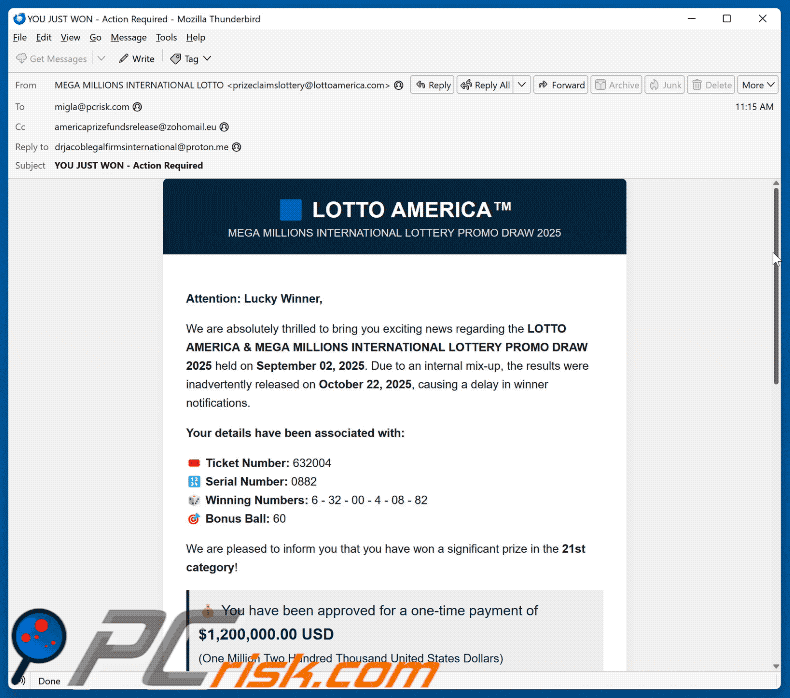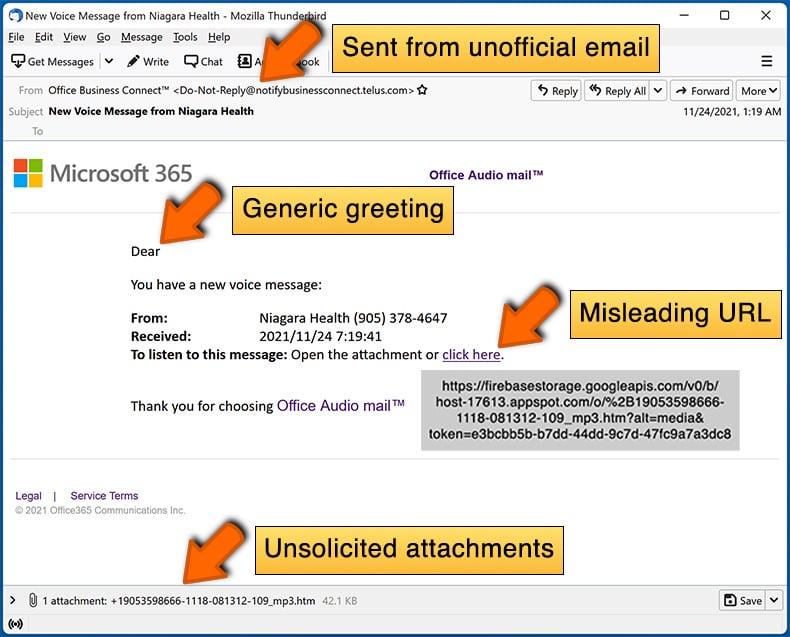How to spot scams like "LOTTO AMERICA" lottery scam
Phishing/ScamAlso Known As: Fake LOTTO AMERICA winning notification
Get free scan and check if your device is infected.
Remove it nowTo use full-featured product, you have to purchase a license for Combo Cleaner. Seven days free trial available. Combo Cleaner is owned and operated by RCS LT, the parent company of PCRisk.com.
What is "LOTTO AMERICA" scam?
We have examined the email and found that it poses as a winning notification from "LOTTO AMERICA". Essentially, it is a scam email designed to steal money and (or) information from unsuspecting recipients. Emails like this one should be ignored and deleted immediately.

More about the "LOTTO AMERICA" scam email
This is a fraudulent lottery notification claiming that the recipient has won a large prize ($1,200,000.00) in an international lottery draw. It falsely states that the results were delayed due to an internal error and provides fake ticket, serial, and winning numbers to appear legitimate.
The email also states that the recipient has been approved for a one-time payment and instructs them to contact a supposed legal representative to claim the prize. It includes requirements such as traveling to the United States to sign documents or using alternative delivery options through an overseas agent.
The message also provides a deadline for claiming the prize and urges the recipient to keep the information confidential. It is a classic example of a lottery scam where fraudsters seek to extract money (to trick recipients into paying fake administration or other fees) or personal information, like credit card details, personal identification information, or other details.
Emails of this type should be ignored to avoid monetary loss, identity theft, or other issues.
| Name | LOTTO AMERICA Email Scam |
| Threat Type | Phishing, Scam, Social Engineering, Fraud |
| Fake Claim | The recipient has won $1,200,000.00 in a lottery |
| Disguise | Message from LOTTO AMERICA |
| Symptoms | Unauthorized online purchases, changed online account passwords, identity theft, illegal access of the computer. |
| Distribution methods | Deceptive emails, rogue online pop-up ads, search engine poisoning techniques, misspelled domains. |
| Damage | Loss of sensitive private information, monetary loss, identity theft. |
| Malware Removal (Windows) |
To eliminate possible malware infections, scan your computer with legitimate antivirus software. Our security researchers recommend using Combo Cleaner. Download Combo CleanerTo use full-featured product, you have to purchase a license for Combo Cleaner. 7 days free trial available. Combo Cleaner is owned and operated by RCS LT, the parent company of PCRisk.com. |
Similar scam emails in general
Scams like this typically promise large winnings to trick recipients into providing money or personal information. They often appear urgent and instructions to contact fake representatives for actions like "claim processing". These emails should always be ignored. Sometimes, they may be used to deliver malware.
Examples of similar scams are "Rainbow Lottery Email Scam", "Promotion Of Powerball Lottery Organization 2025 Email Scam", and "Lottery Winnings Compensation Email Scam".
How do spam campaigns infect computers?
Threat actors often spread malware through email by attaching infected files, including executables, Office documents, PDFs, scripts, or compressed files like ZIP and RAR. Opening these files or enabling features such as macros can trigger the malware and infect the system.
Emails may also contain links to malicious or compromised websites that either download malware automatically or deceive users into downloading it. In both cases, interacting with attachments or clicking links can lead to infection.
How to avoid installation of malware?
Do not open files or click links in shady (including unexpected and irrelevant) emails or messages from unknown or suspicious sources. Avoid interacting with ads, pop-ups, buttons, or links on questionable websites. Do not permit dubious sites to send notifications. Only download software from official websites or app stores.
Also, keep your operating system and security software up to date, and run regular scans to detect potential threats.
Text presented in the "LOTTO AMERICA" email letter:
LOTTO AMERICA™
MEGA MILLIONS INTERNATIONAL LOTTERY PROMO DRAW 2025
Attention: Lucky Winner,
We are absolutely thrilled to bring you exciting news regarding the LOTTO AMERICA & MEGA MILLIONS INTERNATIONAL LOTTERY PROMO DRAW 2025 held on September 02, 2025. Due to an internal mix-up, the results were inadvertently released on October 22, 2025, causing a delay in winner notifications.
Your details have been associated with:
Ticket Number: 632004
Serial Number: 0882
Winning Numbers: 6 - 32 - 00 - 4 - 08 - 82
Bonus Ball: 60We are pleased to inform you that you have won a significant prize in the 21st category!
You have been approved for a one-time payment of
$1,200,000.00 USD
(One Million Two Hundred Thousand United States Dollars)This will be delivered via certified bank cheque or secure bank transfer.
Claim Process:Please contact our legal representative to begin your claim:
Dr. Jacobs International Legal Firms
[Email click reply]You will be required to travel to California, USA to sign the necessary documentation and collect your cheque. If travel is not feasible, certified delivery or bank transfer options are available through your designated overseas agent.
Deadline to Claim: November 12, 2025
Unclaimed winnings will be returned to the Ministry of Economy after this date.
If your personal contact details have changed, please update your claims agent promptly to avoid any delays.
Once again, congratulations on this life-changing win!
CAROLINE GRACE
President
LOTTO AMERICA & MEGA MILLIONS LOTTERYLOTTO AMERICA™
Please keep this information confidential until your claim is processed.
This is an official notification. For security purposes, do not share your winning details publicly.
Appearance of LOTTO AMERICA scam email (GIF):

Instant automatic malware removal:
Manual threat removal might be a lengthy and complicated process that requires advanced IT skills. Combo Cleaner is a professional automatic malware removal tool that is recommended to get rid of malware. Download it by clicking the button below:
DOWNLOAD Combo CleanerBy downloading any software listed on this website you agree to our Privacy Policy and Terms of Use. To use full-featured product, you have to purchase a license for Combo Cleaner. 7 days free trial available. Combo Cleaner is owned and operated by RCS LT, the parent company of PCRisk.com.
Quick menu:
- What is Fake LOTTO AMERICA winning notification?
- Types of malicious emails.
- How to spot a malicious email?
- What to do if you fell for an email scam?
Types of malicious emails:
![]() Phishing Emails
Phishing Emails
Most commonly, cybercriminals use deceptive emails to trick Internet users into giving away their sensitive private information, for example, login information for various online services, email accounts, or online banking information.
Such attacks are called phishing. In a phishing attack, cybercriminals usually send an email message with some popular service logo (for example, Microsoft, DHL, Amazon, Netflix), create urgency (wrong shipping address, expired password, etc.), and place a link which they hope their potential victims will click on.
After clicking the link presented in such email message, victims are redirected to a fake website that looks identical or extremely similar to the original one. Victims are then asked to enter their password, credit card details, or some other information that gets stolen by cybercriminals.
![]() Emails with Malicious Attachments
Emails with Malicious Attachments
Another popular attack vector is email spam with malicious attachments that infect users' computers with malware. Malicious attachments usually carry trojans that are capable of stealing passwords, banking information, and other sensitive information.
In such attacks, cybercriminals' main goal is to trick their potential victims into opening an infected email attachment. To achieve this goal, email messages usually talk about recently received invoices, faxes, or voice messages.
If a potential victim falls for the lure and opens the attachment, their computers get infected, and cybercriminals can collect a lot of sensitive information.
While it's a more complicated method to steal personal information (spam filters and antivirus programs usually detect such attempts), if successful, cybercriminals can get a much wider array of data and can collect information for a long period of time.
![]() Sextortion Emails
Sextortion Emails
This is a type of phishing. In this case, users receive an email claiming that a cybercriminal could access the webcam of the potential victim and has a video recording of one's masturbation.
To get rid of the video, victims are asked to pay a ransom (usually using Bitcoin or another cryptocurrency). Nevertheless, all of these claims are false - users who receive such emails should ignore and delete them.
How to spot a malicious email?
While cyber criminals try to make their lure emails look trustworthy, here are some things that you should look for when trying to spot a phishing email:
- Check the sender's ("from") email address: Hover your mouse over the "from" address and check if it's legitimate. For example, if you received an email from Microsoft, be sure to check if the email address is @microsoft.com and not something suspicious like @m1crosoft.com, @microsfot.com, @account-security-noreply.com, etc.
- Check for generic greetings: If the greeting in the email is "Dear user", "Dear @youremail.com", "Dear valued customer", this should raise suspiciousness. Most commonly, companies call you by your name. Lack of this information could signal a phishing attempt.
- Check the links in the email: Hover your mouse over the link presented in the email, if the link that appears seems suspicious, don't click it. For example, if you received an email from Microsoft and the link in the email shows that it will go to firebasestorage.googleapis.com/v0... you shouldn't trust it. It's best not to click any links in the emails but to visit the company website that sent you the email in the first place.
- Don't blindly trust email attachments: Most commonly, legitimate companies will ask you to log in to their website and to view any documents there; if you received an email with an attachment, it's a good idea to scan it with an antivirus application. Infected email attachments are a common attack vector used by cybercriminals.
To minimise the risk of opening phishing and malicious emails we recommend using Combo Cleaner Antivirus for Windows.
Example of a spam email:

What to do if you fell for an email scam?
- If you clicked on a link in a phishing email and entered your password - be sure to change your password as soon as possible. Usually, cybercriminals collect stolen credentials and then sell them to other groups that use them for malicious purposes. If you change your password in a timely manner, there's a chance that criminals won't have enough time to do any damage.
- If you entered your credit card information - contact your bank as soon as possible and explain the situation. There's a good chance that you will need to cancel your compromised credit card and get a new one.
- If you see any signs of identity theft - you should immediately contact the Federal Trade Commission. This institution will collect information about your situation and create a personal recovery plan.
- If you opened a malicious attachment - your computer is probably infected, you should scan it with a reputable antivirus application. For this purpose, we recommend using Combo Cleaner Antivirus for Windows.
- Help other Internet users - report phishing emails to Anti-Phishing Working Group, FBI’s Internet Crime Complaint Center, National Fraud Information Center and U.S. Department of Justice.
Frequently Asked Questions (FAQ)
Why did I receive this email?
These emails are usually not personalized. Fraudsters send them to thousands of recipients, using addresses gathered from data leaks, fake registrations, or other sources.
I have provided my personal information when tricked by this email, what should I do?
Immediately change any passwords that could have been exposed and inform your bank and relevant authorities if sensitive personal or financial information may be compromised.
I have sent cryptocurrency to scammers, can I get it back?
Usually, crypto transfers on-chain are effectively irreversible. Thus, it is unlikely that stolen cryptocurrency can be recovered.
I have downloaded and opened a malicious file attached to an email, is my computer infected?
Opening an .exe file can immediately compromise a system, while documents and other files typically require user actions (like enabling macros) to activate malware. Risk depends on file type and user behavior.
I have read the email but did not open the attachment, is my computer infected?
Simply viewing an email cannot compromise a device. Malware infiltration occurs only when a user interacts with a malicious link or attachment.
Will Combo Cleaner remove malware infections that were present in email attachment?
Most malware can be removed by Combo Cleaner, yet a thorough system scan is advised to detect advanced and hidden infections.
Share:

Tomas Meskauskas
Expert security researcher, professional malware analyst
I am passionate about computer security and technology. I have an experience of over 10 years working in various companies related to computer technical issue solving and Internet security. I have been working as an author and editor for pcrisk.com since 2010. Follow me on Twitter and LinkedIn to stay informed about the latest online security threats.
PCrisk security portal is brought by a company RCS LT.
Joined forces of security researchers help educate computer users about the latest online security threats. More information about the company RCS LT.
Our malware removal guides are free. However, if you want to support us you can send us a donation.
DonatePCrisk security portal is brought by a company RCS LT.
Joined forces of security researchers help educate computer users about the latest online security threats. More information about the company RCS LT.
Our malware removal guides are free. However, if you want to support us you can send us a donation.
Donate
▼ Show Discussion